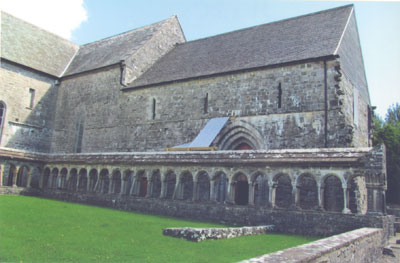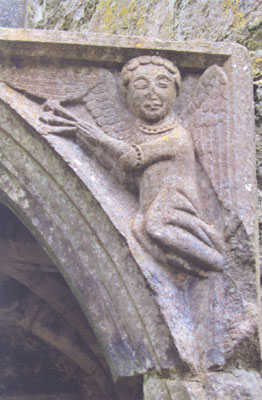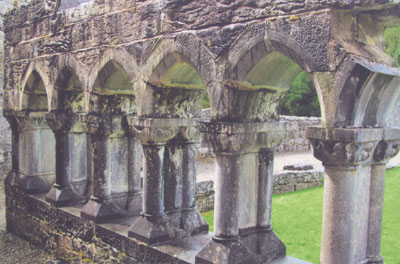Abbeys of County Mayo
This item appears on page 60 of the March 2013 issue.
(2 of 2 on Ireland)
It couldn’t have been more perfect. The kitchen of our rental house in the Irish village of Glashpatrick in County Mayo had floor-to-ceiling windows. Filling the view was the conical shape of Croagh Patrick, Ireland’s holiest mountain, an important place of pilgrimage. St. Patrick is said to have climbed the 2,500-foot mountain in AD 441 and fasted there for 40 days. Some claim that it was also from there that he drove the snakes out of Ireland.
My husband, Paul, and I had the good luck to arrive at our rental the day before Reek Sunday, the last Sunday in July, when thousands of pilgrims labor up the mountain clutching wooden walking sticks as pilgrims have in centuries past. As we breakfasted on Reek Sunday, we watched the long line of climbers making the 4.2-mile round-trip trek. All this practically in our backyard!
However, Croagh Patrick was not the reason we had traveled to County Mayo for two weeks in July-August 2012, although it was a pleasant surprise to find that the mountain was such a close neighbor. Paul and I had gone there to explore the many ruined abbeys of County Mayo in western Ireland.
The area is rich in abbeys that flourished during the Middle Ages only to be destroyed during the Dissolution of the Monasteries in the mid 16th century and the Cromwellian wars of the mid 17th century.
Ballintubber Abbey
The first abbey we visited was Ballintubber, located 13 miles from the lovely town of Westport and 18 miles from our rental.
Founded in 1216 by Cathal O’Conor, King of Connacht (one of the five ancient kingdoms of Ireland), for Augustinian canons, Ballintubber is unusual among the multitude of ruined abbeys. Although it, too, suffered dissolution (1542) and Cromwellian depredation (1653), the church, itself, was never totally destroyed. It was only recently, however, that the church was completely restored… in time for its 750th anniversary in 1966.
The cloister, however, and the buildings surrounding it still lie in ruins, although visitors can stroll along what was once the arcaded cloister pathway. The adjacent cemetery with elaborately carved Celtic crosses shouldn’t be missed. There is an excellent booklet visitors can buy in the bookshop in the old Chapter House that points out highlights in both church and cloisters.
An ancient pilgrimage route passes by Ballintubber. Pilgrims still follow this route on their way to Croagh Patrick, 22 miles away.
Cong Abbey
Cong Abbey, originally founded in the seventh century, was refounded in 1135 by Turlough O’Conor, King of Connacht, for Augustinians. His son, Rory, the last High King of Ireland before the Norman occupation, spent the last years of his life in the abbey until his death in 1198.
What is unique about Cong are three extraordinary doorways with exquisite stone carving as well as a splendid cloister also with wonderful detailed carving. Most of the carving is either abstract or foliate, but there are occasional human faces inserted. One wonders if these are the portraits of the sculptors, themselves.
Moyne Abbey
The sign near Moyne Abbey wasn’t exactly welcoming. It read, “Beware of the Bull.” Although I saw no bull in sight, I was sure there was one lying in wait for us behind an overgrown hedge.
It’s a long trek across fields — 15 to 20 minutes — to reach Moyne Abbey, but it does give the visitor the opportunity to appreciate the abbey’s majestic outline as he slowly approaches, stumbling over little grassy hillocks and shallow gullies. This outline is impressive, with a tall bell tower dominating and with more or less intact outer walls.
Situated 47 miles from Westport, Moyne was founded in 1462 as a Franciscan friary and built in the Gothic style of the period. Moyne is unique because so much of it remains — much of the church, itself, the sturdy arcades of the cloister surrounded by sacristy, chapter house, refectory, kitchen and storehouse and, remarkably, the dormitories that were above these buildings, including their fireplaces.
Moyne was the most complete of these three abbeys and the one which most gave us a feel for what monastic life must have been like in the Middle Ages. As for the bull, he must have been away on holiday. He wasn’t lurking behind a hedge after all.
Abundance of abbeys
In addition to Ballintubber, Cong and Moyne, we visited quite a few other abbeys in County Mayo, all within easy driving distance of Westport, including Murrisk (1457), within a mile of our rental house, with unusual battlemented walls; Kilgeever (12th century), with a holy well still visited by pilgrims; Strade (early 13th century), with a magnificent tomb with Gothic canopy and front tomb panels filled with carved figures, including the Three Magi; Burrishoole (1486), with gravestones paving its nave; Rosserk (1460), with much of the monastic building still intact, and the atmospheric, overgrown Glaspatrick Church (12th century), also practically in our backyard and supposedly built on the fifth-century site of a church founded by St. Patrick, himself.
If you go…
Our house rental in the village of Glashpatrick, five miles west of Westport in County Mayo, was a spacious, modern, 4-bedroom, 3-bathroom house with panoramic views of Clew Bay in front and peaceful views of Croagh Patrick from our backyard.
There was a turf-burning fireplace for chilly nights plus outdoor furniture facing the mountain for warm days. The rental cost $2,000 for two weeks. We found the house listed at www.homeaway.com/142428.
Someplace special
Ashford Castle (phone, in the US, 800/346-7007 or e-mail reservatons@ashford.ie), occupying the site of a 13th-century castle, is the 19th-century creation of Arthur Edward Guinness, Lord Ardilaun. It has been consistently voted one of Europe’s finest hotels, and its prices reflect this fact.
But even if you don’t stay there, you can indulge in the ritual of afternoon tea, served daily from 3 to 5. It’s a leisurely affair of scones with jams and clotted cream, finger sandwiches and pastries presented in the castle’s Drawing Room overlooking a lake. It will cost €23 (about $31) each. A gratuity of 15% is added to this. Reservations are advisable.



